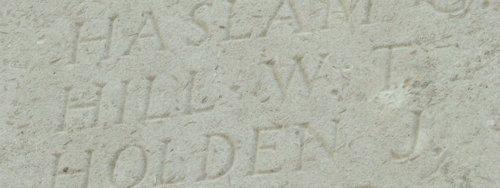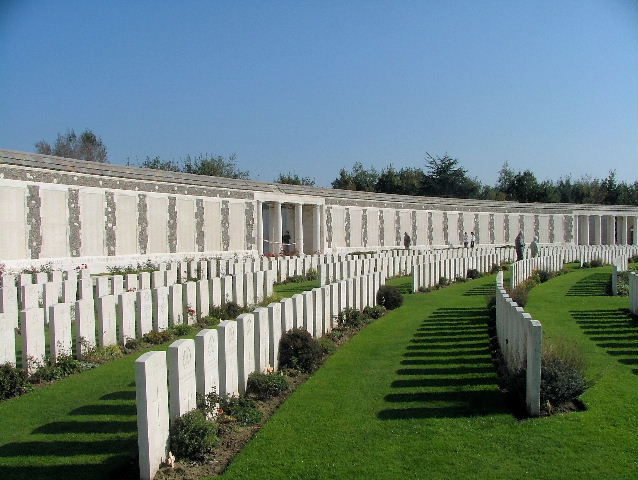Name
William Thomas Hill
Conflict
First World War
Date of Death / Age
09/10/1917
30
Rank, Service Number & Service Details
Lance Corporal
307763
Lancashire Fusiliers
2nd/8th Bn.
Awards: Service Medals/Honour Awards
British War and Victory medals
Cemetery/Memorial: Name/Reference/Country
TYNE COT MEMORIAL
Panel 54 to 60 and 163A.
Belgium
Headstone Inscription
NA
UK & Other Memorials
Pirton Village War Memorial, St Mary’s Shrine, Pirton, Methodist Chapel Plaque, Pirton
Biography
William’s connection to Pirton might have remained a complete mystery, but for one small notice found in the Parish Magazine; in October 1914 a wedding was reported between a Pirton born girl, Florence Rachel Carter, and William Thomas Hill.
This simple clue, together with a report in the August 1918 Parish Magazine listing him with Charles Wilsher as missing, and which gave his Regiment as the Lancashire Fusiliers, enabled the rest of the information appearing here to be found.
William was born in Bodelwyddan, Rhyl, Denbighshire, some time around 1888, and he was very probably christened in the famous marble church of that village, which was erected at a cost of sixty thousand pounds by Lady Willoughby de Broke in memory of her husband. His information was found in the 1891 census and in that census his age is given as three. By then, William’s parents, who were James Arthur and Eliza Hill, and William’s two younger brothers James (b c1889) and Clement (b 1891) had moved to Shirehampton in Gloucestershire. James was working as a watchman on the railway. The family remained living in Shirehampton, in 1901 in 1 Ivy Cottage and then later in 2 Avon View Cottage, Pembroke Road. James continued to work on the railway, but now as a platelayer. The family had expanded with a daughter, Nancy (b c1893).
It is not entirely clear, but it seems possible that William’s mother, Eliza, died some time before 1900 and that James subsequently remarried. This suggestion comes from the various censuses; in 1891 James was married to Eliza, in 1901 to Annie E and in 1911 to Annie Elizabeth – the former born in Bridgnorth and the latter two from Weston under Lizard. As there is a similarity in names and the two locations are only a few miles apart, it is possible that Eliza and Annie Elizabeth are the same person. However, the 1911 census records the marriage as only eleven years old and, despite four children being listed it records only one child from the marriage. Based on this information it seems likely that James had remarried and that the youngest daughter, Elesia (b c1900) was a half-sister to William.
At fifteen, William left school and was learning to be a domestic gardener. He must have worked hard and gained a good reputation as he moved on to become one of the gardening staff at Highclere Castle in Newbury, Berkshire - an important and historic property. The 1911 census confirms this and also lists a Florence Rachel Carter aged twenty-four, as a housemaid and from Pirton. So it seems that they met there and that their marriage is William’s connection to Pirton.
The owner of Highclere was the 5th Earl of Carnarvon who became famous for participating in and funding excavations in Egypt. This he did from 1907, so William and Florence were probably there during his less successful ventures, but not for his most famous – his meeting and funding of Howard Carter and the subsequent discovery of the Tomb of Tutankhamun.
The Fusiliers’ Museum was very helpful in providing information on William’s war service. He was conscripted in late 1916 and sent to the 4th Training and Draft Finding Battalion at Barry Docks in South Wales. After a few months, with training completed, he had joined the 2nd Company, 8th Battalion and was preparing for embarkation to France.
On February 28th 1917 they arrived at Le Havre and then travelled to Thiennes, Paradis, Lestrum and then Béthune. By March 19th they were in the trenches on the front line at Givenchy. In April, May and up to mid-June they continued with the ‘normal’ and dangerous cycle of front line trenches, support and reserve, much of the time in the thick of the fighting around Givenchy. For the latter half of June and the first half of July they were stationed around Dunkerque, either on coastal defence duties or in camp, but by the 24th were back in the trenches, this time at Nieuport. This pattern continued, in and out of the fighting or at the coast, with the only change being the country, as at the end of July they moved to Belgium.
From the beginning of October, William’s last days were spent moving forward and positioning for an attack on Passchendaele – on one of our visits the locals told us to pronounce it ‘passion-da-la’. This was to be part of the Third Battle of Ypres, also known as the Battle of Passchendaele and to the soldiers, from the conditions in which they suffered and fought, the 'Battle of Mud'.
For the Lancashire Fusiliers, October 9th was the first time in their history that two Regular Battalions had fought, shoulder to shoulder, and in all six were fighting that day. Their objective was to take Poelcapelle (now Poelkapelle). Poelcapelle is located about five miles north-east of Ypres and was a strongly fortified German position. This operation was to have its own name, the Battle of Poelcapelle.
Conditions were appalling. It had rained for weeks, the ground was waterlogged and trenches flooded, as were the many shell holes. Men fought and some drowned, especially if they fell, seriously wounded, in no-man’s land. The Commonwealth War Graves Commission’s website explains the conditions succinctly: ‘Aspects of the ensuing fighting conformed to the classic imagery of Western Front trench warfare in which the dominant elements of mud and rain generated a degree of misery for participants which is almost impossible to describe.’
William’s Battalion were due to be in position to attack at 3:20am on the 9th, ‘zero’ hour being 5:20am, and to avoid daylight they moved forward in order to get to position by 6:30pm on the previous evening. Despite allowing nearly nine hours to cover just two and a half miles, the conditions were so bad – men were often up to their waists in water or up to their knees in mud - they failed to meet their deadline. However, by 5:50am it was ‘optimistically’ decided that enough men had arrived to attack. They moved forward and amazingly by 7:20am their first objective had been taken. Casualties were bad, the men kept trying, but by the middle of the day the German defensive fire forced the British withdrawal and, by afternoon, exhausted survivors were back on their start lines and hardly any of the objectives had been won and many men had been lost.
The action was heroic, many medals were won and some of the 2/8th managed to reach the outskirts of Passchendaele – this was proved because their bodies were found when the village was finally captured on November 6th, nearly a full month later - perhaps William got that far. The 2/8th had 35 men killed, 213 wounded and 139 missing (probably killed). William was one of those killed. The sad news was conveyed to his wife who was living at 156 Cronin Road, Commercial Road, Peckham, London.
Tyne Cot is the largest of all Commonwealth War Cemeteries and contains 11,954 graves of the British Army of the Great War. The sheer size of the cemetery brings deep emotion, but in William’s case, as his body was never found, it is not the cemetery that is of primary interest but the memorial wall - the ‘Memorial to the Missing’. This wall is at the back of the cemetery and it is now the rear of this wall that you pass from the car park to gain entry. So many names are listed that, in order to include them all, a number of bays were created. William is commemorated in Bay 55 on the north-eastern boundary, one of 34,885 names. The bays offer a sanctuary for peaceful and secluded contemplation and a chance to come to terms with what you have seen in the cemetery.
Additional Information
Text from the book: The Pride of Pirton
Acknowledgments
The Pride of Pirton book – www.pirton.org.uk/prideofpirton Chris Ryan / Tony French / Jonty Wild



